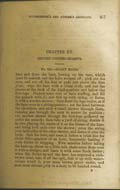Skin and draw the hare, leaving on the ears, which must be scalded, and the hairs scraped off; pick out the eyes, and cut off the feet or pads just above the first joint; wipe the hare with a clean cloth, and cut the sinews at the back of the hind-quarters and below the fore-legs. Prepare some veal or hare stuffing, and fill the paunch with it; sew this up with string, or fasten it with a wooden skewer; then draw the legs under, as if the hare were in a sitting posture; set the head between the shoulders, and stick a small skewer through them, running also through the neck to secure its position; ran another skewer through the fore-legs gathered up under the paunch; then take a yard of string, double it in two, placing the centre of it on the breast of the hare, and bring both ends over the skewer; cross the string over both sides of the other skewer, and fasten it over the back. Spit the hare, and roast it before a brisk fire for about three-quarters of an hour, frequently basting it with butter or dripping. Five minutes before taking the hare up, throw on a little salt, shake some flour over it with a dredger, and baste it with some fresh butter; when this froths up and the hare has acquired a rich-brown crust, take it off the spit, dish it up with watercresses round it, pour some brown gravy under, and send some currant jelly in a boat, to be handed round.
